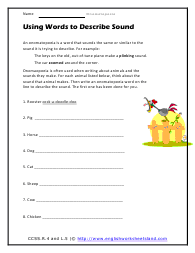Onomatopoeia Worksheets To Print:
Using Words to Describe Sound - What sounds do the animals make? Onomatopoeia is often used when writing about animals and the sounds they make. For each animal listed below, think about the sound that animal makes. Then write an onomatopoeia word on the line to describe the sound.
Sounds Like... - Rewrite each sentence to add more feeling to it. : Rewrite each sentence below, using onomatopoeia to make the sentence more interesting.
Descriptive Language - Which word makes the best sense for each sentence? You may have to get these thoughts in your mind.
Fill It With Boxes - Pick the word that makes the sentence more appealing to your sense of sound.
Where Is It? - Some of these sentences are very loud. Onomatopoeia is a kind of descriptive writing that helps bring your work to life.
Conveying Sound with Words - You will need to underline a bit here. You will be looking for where the sound is described within each sentence.
Sound Words - Where is the sense word in each entry? You just need to write the word that they are looking for on line.
Making Sounds with Words - For each descriptive word below, draw a picture of an animal that would make that sound.
Expressing Sound with Words - What do all of the words have in common? Describe the circumstances in which you might hear the sound being described.
Automotive Onomatopoeia - Each sound here refers to an automobile. Can you guess what the sound is describing? Write your guess for each sound in the box!
Sounds The Same - More work of recognition of sounds. Find the use in each sentence and underline it.
Song Remains the Same - Your asked to create your own well thought out sentences using the technique that we have been learn about.
Sound Words - Complete each sentence below with a word from the Word Bank. There is a word bank to help you with this one.
Writing with Onomatopoeia - Write 5 original sentences using the helping words provided.
Match-up! - We couldn't leave you without a matching activity to play with. This one is very helpful.
Get FREE English Worksheets In Your Email

